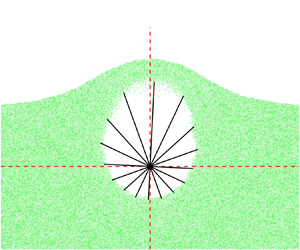No CrossRef data available.
Published online by Cambridge University Press: 26 September 2024

Cavity evolution in granular media is crucial in explosion-driven gas–particle flows, particularly in many engineering applications. In this study, a theoretical model was first proposed to describe the cavity evolution in granular media by extending the classical Rayleigh–Plesset model. A closed equation set comprising the radius, pressure and gas leak-off velocity equations was built by considering the gas expansion and non-Darcy gas-penetration effects. Both centrally symmetric and non-centrally symmetric cases of gas injection into granular media were investigated. Especially for modelling the non-symmetric scenario, the radius and gas leak-off velocity equations were proposed in each radial direction with angle  $\theta$, and then the pressure equation was built up based on the integral gas leak-off along the cavity outline. Through non-dimensionalizing the theoretical equations, four key dimensionless numbers
$\theta$, and then the pressure equation was built up based on the integral gas leak-off along the cavity outline. Through non-dimensionalizing the theoretical equations, four key dimensionless numbers  $\varPi_1,\ \varPi_4$ were obtained to characterize the response time of cavity expansion and the intensity of non-Darcy effects for both cases. This allowed us to determine a scaling law of effective cavity radius
$\varPi_1,\ \varPi_4$ were obtained to characterize the response time of cavity expansion and the intensity of non-Darcy effects for both cases. This allowed us to determine a scaling law of effective cavity radius  $R_{eff}^*=\sqrt {2\varPi _2/(7{\rm \pi} )}t^{*1/2}$ and the critical time
$R_{eff}^*=\sqrt {2\varPi _2/(7{\rm \pi} )}t^{*1/2}$ and the critical time  $t_{cr}^*=\sqrt {12.5/\varPi _1}$ for two-dimensional cavity evolution. Additionally, the necessity of incorporating non-Darcy effects was ascertained under conditions of
$t_{cr}^*=\sqrt {12.5/\varPi _1}$ for two-dimensional cavity evolution. Additionally, the necessity of incorporating non-Darcy effects was ascertained under conditions of  $\varPi _4>400$. The findings demonstrate that the proposed theoretical equations effectively predict the cavity evolution results under various operational conditions (
$\varPi _4>400$. The findings demonstrate that the proposed theoretical equations effectively predict the cavity evolution results under various operational conditions ( $0.7<\varPi _1<7\times 10^2, 3<\varPi _4<1.1\times 10^3$), as validated by refined Euler–Lagrange numerical simulations.
$0.7<\varPi _1<7\times 10^2, 3<\varPi _4<1.1\times 10^3$), as validated by refined Euler–Lagrange numerical simulations.